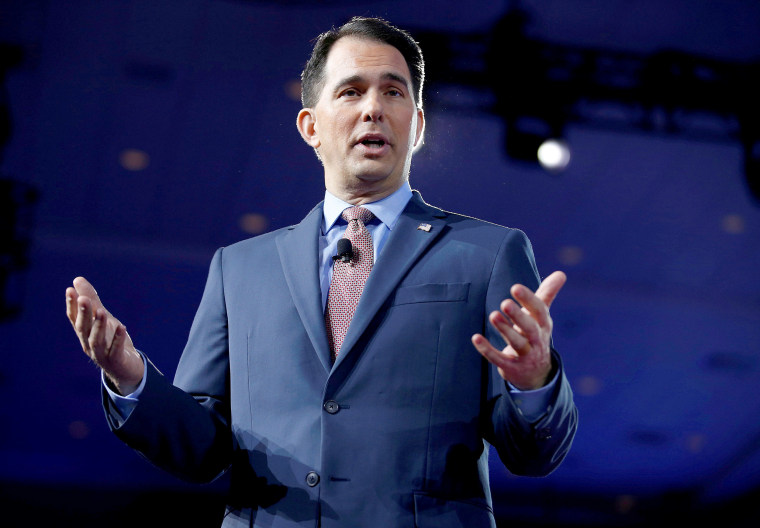There’s an old adage in politics that power corrupts and that absolute power corrupts absolutely. Recent events in Raleigh, North Carolina, and Madison, Wisconsin, suggest that perhaps we should add an addendum to this oft-repeated quip — the threat of lost power corrupts the most of all.
As has been covered in the national media, Wisconsin, a quintessential swing state that is often considered a key to the presidency, has been embroiled in a battle over who controls the levers of power in state government. The Republicans have controlled the governorship and both houses of the state legislature since 2013. And in that time, they have slowly but successfully pushed forward a conservative agenda that, while not popular among Democrats, was consistent with electoral outcomes in the state.
That methodical approach was thrown out the window when Democrats swept the statewide races in November, including the race for governor, foretelling a future of Wisconsin politics that would soon pit a Republican majority in the state legislature against a Democratic governor-elect Tony Evers. Facing an incoming Democratic governor, what was the Republican majority to do? Their answer was to grab the levers of power and shift them quickly and inexorably toward the offices they will still hold (the state legislature) and away from those they will not (the governor’s mansion) before the opposing party is sworn in. And this is exactly what happened on Friday, when outgoing Wisconsin Gov. Scott Walker, a Republican, signed into law a sweeping set of bills passed by the lame-duck GOP-controlled legislature.
Time will tell what the longterm impact of these changes are, but the intent is clear: tilt the scales towards the GOP, electoral results be damned.
Widely condemned by political observers in the state and outside of it, this power grab is not, in fact, new. This no-holds-barred approach to state politics borrows heavily from what happened 914 miles away in Raleigh, North Carolina in 2016. North Carolina, like Wisconsin, is a swing state. Also like Wisconsin, the Republican party was dismayed after a Democratic gubernatorial candidate, Roy Cooper, squeaked out a victory over a Republican incumbent, Pat McCrory.

Faced with the prospects of a Republican supermajority in the General Assembly and a Democratic governor, Republican legislators began to reduce the governor’s power one step at a time, beginning with reducing the number of gubernatorial appointments five-fold. It’s worth noting that the North Carolina governor was already extraordinarily weak compared to governors of most other states. But Republicans somehow found ways to make an already disempowered office even weaker.
The only meaningful difference between the approaches in Wisconsin and North Carolina is the speed of implementation. In contrast to Wisconsin, the Republican General Assembly in North Carolina enjoyed two years of a veto-proof majority following the Democratic gubernatorial win. As a result, institutional changes in North Carolina were implemented more slowly, but are nonetheless substantively similar to those in Wisconsin.
The North Carolina case does suggest that there could be a theoretical limit to how far the Wisconsin Republicans can push this agenda, however. In the last session of the North Carolina General Assembly, the legislature put a record six constitutional amendments on the 2018 state election ballot. While most of the votes broke down along predictable partisan lines, two referenda aimed at reducing the power of the governor made for strange bedfellows. The first amendment would have removed the power of the governor to fill vacancies, and the second would have removed the power of the governor to appoint members of a statewide board of ethics and elections. While the Republicans in the General Assembly overwhelmingly supported these amendments, every living ex-governor of North Carolina, including Republicans James Martin and Pat McCrory, came out against them. Indeed, McCrory’s condemnation was perhaps the most forceful, as he urged voters: “do not hijack our Constitution.”
North Carolina citizens listened to McCrory and his fellow governors: more than 60 percent voted against the two amendments. It’s noteworthy that these amendments failed overwhelmingly while other Republican-backed amendments passed quite easily. Clearly, the people of North Carolina are not unilaterally opposed to Republican policies, but they are opposed to further attempts to shift power from the executive to the legislative branch.
Both North Carolina and Wisconsin illustrate many of the most vexing trends in American politics: the rise in no-holds-barred politics, the increasing nationalization of American politics and the seemingly intractable partisan polarization that defines our times. At the same time, North Carolina suggests that, when given the opportunity, voters can distinguish between policies they like and policies they don’t — even when they are proposed by the same party. Perhaps the solution in Wisconsin is to turn to the voice of the people and listen for the answer.
